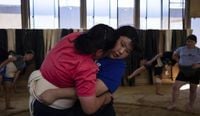Sumo in Japan is more than just a sport—it’s a centuries-old spectacle woven into the nation’s spiritual and cultural fabric. For 1,500 years, sumo has been steeped in Shinto ritual and ceremony, with every match echoing ancient tradition. Yet, at the heart of this revered institution lies a barrier that refuses to budge: women are still strictly barred from the professional dohyō, or sumo ring. But change is rumbling beneath the surface, and a new generation of female rikishi is making its presence felt in a world long dominated by men.
While professional sumo remains off-limits to women, the amateur scene is blossoming. Over 600 female wrestlers—known as rikishi—are now active across Japan, training rigorously and dreaming big. Their ambitions are set on the international stage, with the men’s and women’s amateur sumo world championships kicking off this weekend in Bangkok. For these women, the tournament is more than just a competition—it’s a statement of intent.
One of the brightest stars in this movement is 27-year-old Airi Hisano. By day, she works at Tachihi Holdings. By night—and on weekends—she transforms into Japan’s strongest female sumo wrestler, tipping the scales at 115 kilograms and standing 1.72 meters tall. Hisano is the sole member of her company’s women’s sumo club, but that hasn’t dimmed her determination. “I want sumo to become an Olympic sport with no gender distinction,” she declares, her voice filled with conviction.
Her coach, Daiki Toyonoshima, a former pro rikishi himself, is quick to praise Hisano and the sport’s female competitors. “Watching them throw each other and fall face-first without using their hands was deeply impressive,” Toyonoshima says. “Women’s sumo is powerful and matches the intensity of male bouts.” The energy and skill on display, he insists, leave no doubt that women belong on the mat.
Support for women’s sumo isn’t limited to coaches and athletes. Veteran NHK broadcast commentator and club manager Fujio Kariya believes women’s participation could be a catalyst for broader societal change. “It can spark real change—not just in sports, but across Japanese society,” Kariya notes, pointing to the rigid gender roles that still shape daily life in Japan. For many, the rise of female rikishi represents not just a sporting revolution, but a cultural one.
At the Keio University Sumo Club in Tokyo, tradition and progress collide in the best possible way. Here, women and men—and even boys from the Keio High School team—train side by side. This wasn’t always the case. The club, founded in 1919, welcomed its first female member only recently: Rio Hasegawa. At 22, Hasegawa is already the 2024 middleweight world champion, standing 1.71 meters tall and weighing 72 kilograms. Her powerful build is a testament to the demands of the sport.
But sumo isn’t just about strength—it’s about identity. Unlike their male counterparts, who compete bare-chested in the traditional mawashi (loincloth), women wear the mawashi over spandex shirts and bodysuits, a nod to cultural modesty. “It’s unavoidable—women have body parts that must be covered,” Hasegawa explains. “I’ve never wanted to compete dressed like a man.” For her, the uniform is more than just clothing; it’s a statement about body image and self-acceptance. “If I quit sumo,” she admits, “I might think about losing weight.”
The pressures faced by female rikishi go far beyond the ring. In a society where “slim is often equated with beautiful,” as 19-year-old Shiho Suzuki points out, women in sumo often find themselves at odds with mainstream expectations. Suzuki, one of four female rikishi at Keio, stands 1.6 meters and weighs 78 kilograms. “But for performance and health, thin isn’t everything. A strong, healthy body with some weight on it is attractive, too.”
Not all the challenges are internal. Teasing and outright bullying are common, especially for younger girls. Keio University sophomore Nana Nishida recalls losing 20 kilograms in middle school—about 45 pounds—in a desperate attempt to make the bullies stop. “Sumo is a sport where you cannot win with technique alone,” Nishida says. “It’s important to make use of your body type.” Her experience is echoed by many young women entering the sport, who must navigate both physical training and social stigma.
Despite these obstacles, a new generation is forging ahead. Since 2016, girls from all over Japan have traveled to Tottori Jōhoku High School, about 600 kilometers west of Tokyo—an eight-hour drive—to attend week-long spring and summer training camps at the nation’s largest girls’ sumo club. The camps focus on building strength, honing technique, and, yes, bulking up. Meals are hearty affairs: pork in a tangy sauce, vegetables, white rice, and candied sweet potatoes. Ritual weight checks before and after eating are standard practice. “We eat to build muscle and maintain our weight,” says 15-year-old Sora Kusuda from Osaka, who has practiced sumo for seven years and weighs 110 kilograms at 1.65 meters tall. Kusuda isn’t trying to lose weight—instead, she’s focused on getting stronger. “I want,” she says, “to become a world champion.”
Their goals stand in stark contrast to broader trends in Japanese society. Government data shows that more than 20% of Japanese women in their 20s and 30s are underweight, a statistic that highlights just how different the world of female sumo is. Here, strength and mass are celebrated, not shamed. For these young athletes, the dohyō is a rare space where their bodies are valued for what they can do, not just how they look.
With the international sumo world championships set to begin in Bangkok, the spotlight is firmly on Japan’s female rikishi. Their presence is already shaking up tradition, and their ambitions reach far beyond the ring. Will the sacred world of sumo eventually open its doors to women at the highest level? The answer remains uncertain. But one thing’s for sure: the next generation of female wrestlers is determined to make history, one bout at a time.
As the action unfolds in Bangkok this weekend, all eyes are on the women who refuse to be sidelined. Their journey is far from over, but their impact is already being felt—both inside and outside the ring.


